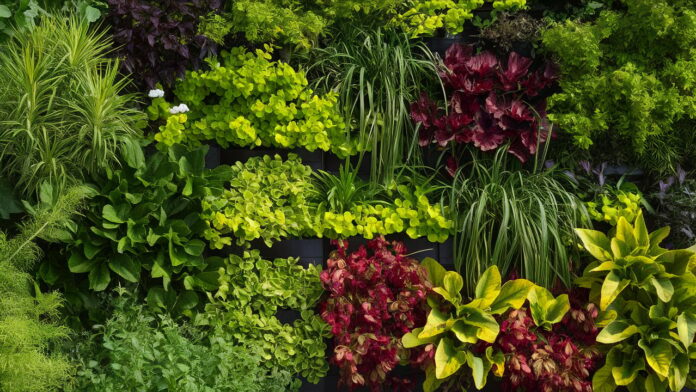In urban areas where space is a premium commodity, traditional gardening methods often seem unfeasible. However, the concept of vertical gardening has emerged as a practical and visually appealing solution for those with limited ground space. The image you provided serves as a prime example of how lush and productive a vertical garden can be. This article will delve into the essentials of creating your own vertical garden, offering tips, benefits, and an easy-to-follow guide.
Why Vertical Gardening?
1. Space Efficiency
Vertical gardens utilize vertical structures to grow plants, allowing gardeners to maximize space. This method is particularly beneficial for urban dwellers with limited outdoor space.
2. Aesthetic Appeal
Vertical gardens add a unique, modern touch to any space. They can transform dull walls and fences into vibrant, living art pieces, enhancing the overall aesthetic of your environment.
3. Improved Air Quality
Plants are natural air purifiers. A vertical garden can improve air quality by absorbing pollutants and releasing oxygen, contributing to a healthier living environment.
4. Thermal Insulation
Vertical gardens can provide thermal insulation for buildings, reducing energy consumption for heating and cooling. The plants absorb sunlight and create a cooling effect through transpiration.
5. Increased Biodiversity
Vertical gardens can support a diverse range of plants and even attract beneficial insects, promoting a balanced ecosystem within your urban environment.
Steps to Create a Vertical Garden
1. Planning and Design
Choose the Location
Selecting the right location is crucial. Consider the amount of sunlight the area receives, as different plants have varying light requirements. South-facing walls are ideal for sun-loving plants, while north-facing walls suit shade-tolerant species.
Determine the Structure
Decide on the type of structure for your vertical garden. Options include trellises, wall-mounted planters, vertical pallets, and modular panels. The structure should be sturdy enough to support the weight of the plants and soil.
2. Select the Plants
Light Requirements
Choose plants that match the light conditions of your selected location. For sunny spots, consider herbs like basil, rosemary, and thyme, or flowering plants like petunias and marigolds. For shadier areas, ferns, ivy, and lettuce are good options.
Growth Habits
Consider the growth habits of the plants. Vining plants, such as tomatoes and cucumbers, are excellent for vertical growth. Compact plants, like succulents and certain flowers, work well in pockets or wall-mounted planters.
3. Prepare the Structure
Installation
Install your chosen structure securely. If using wall-mounted planters, ensure they are evenly spaced and anchored properly. For freestanding structures, make sure they are stable and level.
Soil and Planting Medium
Select a high-quality potting mix appropriate for your plants. Vertical gardens often require lightweight soil to reduce strain on the structure. Consider adding organic matter to enhance nutrient content and water retention.
4. Planting
Arrangement
Plan the arrangement of your plants based on their mature size and light requirements. Place taller or trailing plants at the top, allowing them to cascade down, and shorter plants at the bottom to create a balanced look.
Planting Process
Carefully plant your chosen species into the structure, ensuring they are securely positioned. Water the plants thoroughly after planting to help them establish roots.
5. Maintenance
Watering
Vertical gardens may dry out faster than traditional gardens, so regular watering is essential. Consider installing a drip irrigation system for consistent moisture levels.
Pruning and Harvesting
Regularly prune your plants to maintain their shape and promote healthy growth. Harvest herbs and vegetables as needed, which will also encourage new growth.
Monitoring for Pests
Keep an eye out for pests and diseases. Integrated pest management techniques, such as introducing beneficial insects, can help maintain a healthy garden without the use of harsh chemicals.
Benefits of Vertical Gardening
1. Health Benefits
Gardening has been shown to reduce stress and improve mental well-being. Engaging with a vertical garden can provide these therapeutic benefits while also promoting physical activity.
2. Access to Fresh Produce
Growing your own herbs and vegetables ensures access to fresh, organic produce. This can lead to healthier eating habits and reduce reliance on store-bought items.
3. Environmental Impact
Vertical gardens contribute to environmental sustainability by increasing green spaces in urban areas, reducing the heat island effect, and providing habitats for wildlife.
4. Cost-Effectiveness
While initial setup costs can vary, vertical gardens can be cost-effective in the long run. Growing your own produce reduces grocery bills, and the insulating properties of the garden can lower energy costs.
5. Educational Opportunities
Vertical gardens offer excellent educational opportunities for children and adults alike. They provide hands-on learning experiences about plant biology, ecology, and sustainable practices.
Tips for Successful Vertical Gardening
1. Start Small
Begin with a small section of vertical gardening to gain experience and understand the specific needs of your plants. Gradually expand as you become more confident.
2. Choose Hardy Plants
Select hardy, low-maintenance plants to start with. This ensures your vertical garden remains healthy and reduces the potential for frustration.
3. Regular Maintenance
Consistent maintenance is key to a thriving vertical garden. Regularly check for signs of stress, nutrient deficiencies, and pest infestations.
4. Optimize Watering
Consider the watering needs of your plants and invest in a drip irrigation system if possible. This ensures even watering and reduces the risk of over or under-watering.
5. Incorporate Composting
Use compost to enrich the soil in your vertical garden. Composting kitchen scraps and garden waste can provide a sustainable source of nutrients for your plants.
Conclusion
Vertical gardening is a versatile and innovative solution for urban gardening challenges. It offers numerous benefits, from space efficiency and aesthetic appeal to improved air quality and access to fresh produce. By following the steps outlined in this guide, you can create a beautiful and productive vertical garden, regardless of the size of your available space. Embrace this modern gardening method to enhance your environment, promote sustainability, and enjoy the myriad benefits of growing your own plants vertically.



